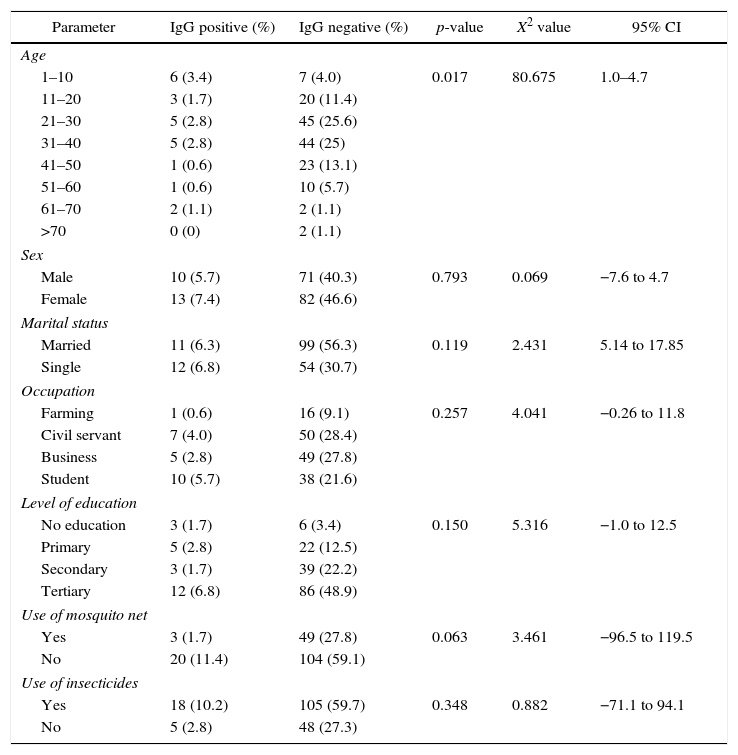Chikungunya virus (CHIKV) is a mosquito borne Alphavirus which has emerged and reemerged. Symptoms of Chikungunya virus infection and malaria parasite infection are almost indistinguishable and cases of misdiagnosis are not uncommon. In Nigeria and most developing countries, malaria or typhoid is usually ascribed to patients with febrile clinical manifestations1 unless otherwise confirmed by laboratory testing to assess for arboviral infection. The latter is not always so, especially in the Nigeria healthcare system. The seroprevalence of Chikungunya virus within Ilorin metropolis has not been reported. This study therefore investigates the seroprevalence of this infection as well as its associated risk factors.
A cross-sectional study of febrile subjects within Ilorin metropolis was conducted using a multistage sampling technique. A total of 176 febrile subjects attending major hospitals within Ilorin East and Ilorin South Local Government were recruited. Infants (<1 year old) were excluded from the survey. Standardized close ended questionnaires were administered to collect data on demographics, symptoms, and mosquito control measures of subjects. Blood samples were collected and the sera were tested for CHIKV IgG using ELISA as described by Sergon et al.2 Subject exposed to CHIKV infection was defined as any subject with IgG antibodies to CHIKV infection in serum. Real Time Quantitative Polymerase Chain Reaction (RT-qPCR) using already published3 CHIKV primers was performed to confirm the presence of CHIKV RNA in 13 ELISA positive sera samples with higher optical densities. Ethical approval was obtained from the Ethical Review Committee (ERC) of Kwara State Ministry of Health. In addition, informed consent was obtained from the subjects. The data generated where analyzed using Microsoft Excel 2007 and SPSS version 21.
Out of 176 subjects tested for anti-Chikungunya IgG antibodies, 23 (13%) were seropositive. This low seroprevalence could imply a minimal circulation of the virus in the area. It contradicts the report of Baba et al.1 that recorded a higher (55%) prevalence in Maiduguri, North Eastern Nigeria. Age was significantly associated to Chikungunya virus acquisition (Table 1). Age group 1–10 [6 (3.4%)] had the highest seropositivity while subjects older than 70 years were the least (Table 1). The presence of CHIKV RNA was confirmed in 10 out of 13 IgG ELISA seropositive cases following RT-qPCR.
Seroprevalence of anti-Chikungunya virus IgG antibody of subjects in relation to socio-demographic and predisposing factors.
| Parameter | IgG positive (%) | IgG negative (%) | p-value | X2 value | 95% CI |
|---|---|---|---|---|---|
| Age | |||||
| 1–10 | 6 (3.4) | 7 (4.0) | 0.017 | 80.675 | 1.0–4.7 |
| 11–20 | 3 (1.7) | 20 (11.4) | |||
| 21–30 | 5 (2.8) | 45 (25.6) | |||
| 31–40 | 5 (2.8) | 44 (25) | |||
| 41–50 | 1 (0.6) | 23 (13.1) | |||
| 51–60 | 1 (0.6) | 10 (5.7) | |||
| 61–70 | 2 (1.1) | 2 (1.1) | |||
| >70 | 0 (0) | 2 (1.1) | |||
| Sex | |||||
| Male | 10 (5.7) | 71 (40.3) | 0.793 | 0.069 | −7.6 to 4.7 |
| Female | 13 (7.4) | 82 (46.6) | |||
| Marital status | |||||
| Married | 11 (6.3) | 99 (56.3) | 0.119 | 2.431 | 5.14 to 17.85 |
| Single | 12 (6.8) | 54 (30.7) | |||
| Occupation | |||||
| Farming | 1 (0.6) | 16 (9.1) | 0.257 | 4.041 | −0.26 to 11.8 |
| Civil servant | 7 (4.0) | 50 (28.4) | |||
| Business | 5 (2.8) | 49 (27.8) | |||
| Student | 10 (5.7) | 38 (21.6) | |||
| Level of education | |||||
| No education | 3 (1.7) | 6 (3.4) | 0.150 | 5.316 | −1.0 to 12.5 |
| Primary | 5 (2.8) | 22 (12.5) | |||
| Secondary | 3 (1.7) | 39 (22.2) | |||
| Tertiary | 12 (6.8) | 86 (48.9) | |||
| Use of mosquito net | |||||
| Yes | 3 (1.7) | 49 (27.8) | 0.063 | 3.461 | −96.5 to 119.5 |
| No | 20 (11.4) | 104 (59.1) | |||
| Use of insecticides | |||||
| Yes | 18 (10.2) | 105 (59.7) | 0.348 | 0.882 | −71.1 to 94.1 |
| No | 5 (2.8) | 48 (27.3) | |||
X2, Chi square; CI, confidence interval; p<0.05, statistical significance at 95% confidence interval.
This study established the exposure of subjects within Ilorin metropolis to Chikungunya virus, which suggests that the virus may be in circulation among the study population. Proper diagnostic measures and adequate vector control scheme should therefore be put in place to monitor and reduce the associated morbidity of the disease.
Conflicts of interestThe authors declare no conflicts of interest.





